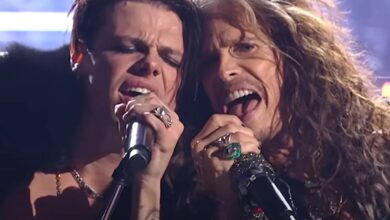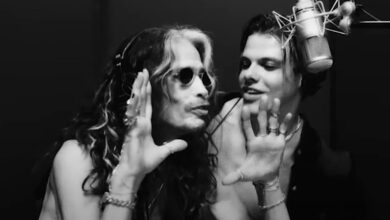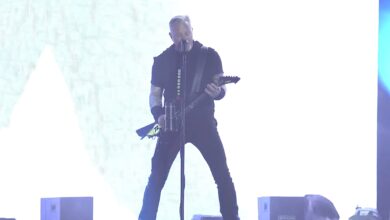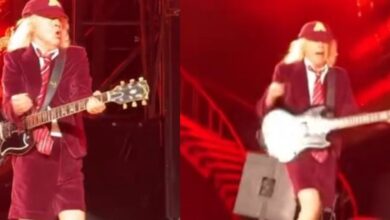Aerosmith and YUNGBLUD Crash Into 2025 with the Explosive “Back in the Saddle”
The night Aerosmith and YUNGBLUD collided around “Back in the Saddle” didn’t feel like a routine collaboration or a nostalgia-driven cameo. It felt like a raw, unfiltered explosion of energy between two generations who understand rebellion from completely different angles. Aerosmith, long considered immortal even in their semi-retired state, came into the moment with the weight of decades behind them. YUNGBLUD, fiery and unpredictable, arrived like a spark looking for gasoline. When they met, the song didn’t just revive — it went feral.
What added depth to the performance was the history leading up to it. The pair had first ignited public excitement during their joint appearance at the 2025 MTV Video Music Awards tribute to Ozzy Osbourne. It was already a night loaded with nostalgia, grief, and celebration. Seeing YUNGBLUD open with raw intent and then watching Steven Tyler step in with that unmistakable rasp created a cultural collision that felt almost destined. Fans immediately sensed that the chemistry between them was more than a one-off tribute moment.
Following that event, rumors of a collaboration didn’t seem far-fetched. Rock music has always reinvented itself through clashes like this — younger artists injecting electric urgency into what older icons forged decades before. Tyler spoke openly about wanting to channel whatever power he had left into projects with meaning rather than routine tours. YUNGBLUD, by contrast, seemed hungry for a chance to stand toe-to-toe with giants. Their energies didn’t cancel each other out; they fused into a force neither could summon alone.
Choosing “Back in the Saddle” as the centerpiece of their collaboration was a deliberate nod to Aerosmith’s own history. The original track has always carried a swagger that feels larger than life — a thunderous riff galloping in like a stampede and a chorus that hits with the subtlety of a wrecking ball. Released in the late 1970s, it built its reputation steadily as one of the band’s loudest live anthems. Even listeners who don’t know Aerosmith deeply recognize that opening guitar assault as one of rock’s most defiant calls to arms.
When talk of a new 2025 version began circulating online, fans didn’t know what to expect. Some wanted a faithful revival, others hoped for a modern twist that embraced YUNGBLUD’s intensity. What emerged hit the perfect balance: Aerosmith’s classic structure remained intact, but the energy was turned up in a way that felt explosive rather than polished. Nothing about it sounded safe or sterilized; instead, it carried the messy, combustible spirit of a real rock revival.
Onstage, the dynamic between the two performers became the core of the experience. Steven Tyler, his voice now edged with more grit than ever, leaned into the song’s dangerous swagger like someone who knows exactly what fires he’s playing with. YUNGBLUD tore into his parts with reckless precision, bringing a younger fury that didn’t mimic Aerosmith — it challenged them. The collision of their vocal styles gave the performance its teeth, each voice pushing the other higher.
Joe Perry’s guitar work acted like the spine of the entire moment. That iconic riff, played with the same force that built stadiums decades ago, came roaring back without apology. Perry attacked the strings as though time had no say in his playing, and the riff became a bridge between generations. YUNGBLUD didn’t just sing over it — he reacted to it, chased it, and let it drag him deeper into the chaos of the song. That tension is what made the performance feel alive instead of ceremonially respectful.
There was also an emotional undercurrent woven beneath all the swagger. Aerosmith isn’t touring full-time anymore, and fans are painfully aware of the health struggles and transitions that have shaped this era. So when they show up for a performance like this, it feels monumental rather than routine. “Back in the Saddle” became more than a song title — it was a statement that the fire hasn’t gone out, even if the band appears less frequently. Hearing Tyler belt those lines today brings a weight that wasn’t there decades ago.
For YUNGBLUD, the moment functioned entirely differently. He approached Aerosmith not as untouchable legends, but as living, breathing partners in crime. That attitude kept the performance from slipping into sentimentality. Instead, it stayed dangerous, loud, and unpredictable — the way rock is meant to be when its pulse is strongest. The spark in his delivery made it clear he wasn’t there to pay tribute; he was there to join the fight.
Fans immediately felt the authenticity behind the collaboration. Online reactions centered around how unexpectedly seamless the pairing sounded. Longtime Aerosmith followers praised Tyler’s endurance and Perry’s still-crushing guitar tone. Younger fans commented on how YUNGBLUD’s presence injected a modern volatility without breaking the spirit of the original. Even skeptics who typically resist cross-generation collaborations found themselves admitting that the energy was impossible to deny.
What made the 2025 mix stand out further was its refusal to smooth out the rough edges. This wasn’t a glossy, radio-tailored reinvention. The track kept every crackle, grunt, and breath that gave the original its punch. Aerosmith built their legacy on a kind of raw imperfection that felt honest and human; YUNGBLUD thrives on chaos. The combination produced something far more visceral than a standard remake. It felt like they intentionally left the claws on.
Beyond the music itself, the performance said something about where rock stands today. In a fragmented era where genres blend, fade, or fracture, moments like this serve as reminders that rock’s backbone still exists — not as nostalgia, but as a living force passed between generations. The meeting point between Aerosmith’s legacy and YUNGBLUD’s wild youth showed that rock isn’t tied to a single age group. It’s tied to attitude, resistance, and volume.
The reason “Back in the Saddle” continues to thrive across decades is its architecture. The groove is built for crowds, the chorus is a battle cry, and the progression carries an adrenaline rush that doesn’t fade with time. The 2025 version proved the song’s core is as unbreakable as ever. It stands up to new voices without losing the identity that made it iconic.
There’s a poetic symmetry in the collaboration emerging from an event honoring Ozzy Osbourne — a musician who symbolized unity between eras and subgenres. To see Aerosmith and YUNGBLUD first connect under that roof and then carry that spark into a studio collaboration felt like a continuation of the same lineage of rock storytelling. It hinted at a future where the weight of legacy and the thrill of youth coexist instead of competing.
By the time the performance carved its place into fan memory, it was clear the collaboration had become more than a remix or a symbolic crossover. It was a rallying cry. For Aerosmith, it declared that the spirit of the band lives on even in rare appearances. For YUNGBLUD, it marked another milestone in his mission to pull rock back into the center of cultural conversation. For fans of all ages, it was a reminder that some songs aren’t just played — they’re unleashed.
If they never share a stage again, this moment still stands as a beacon. But if more performances emerge from this connection, they will likely arrive the same way this one did — unexpectedly, explosively, and entirely on their own terms. What’s certain is that “Back in the Saddle” now carries a new chapter in its history, proving once again that as long as someone is bold enough to grab the reins, the ride never truly ends.





